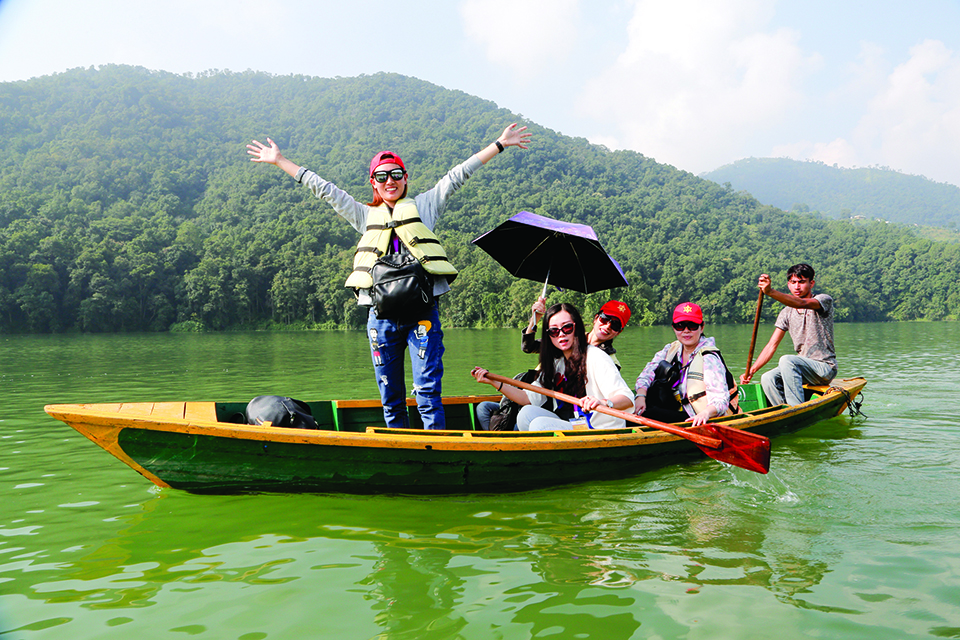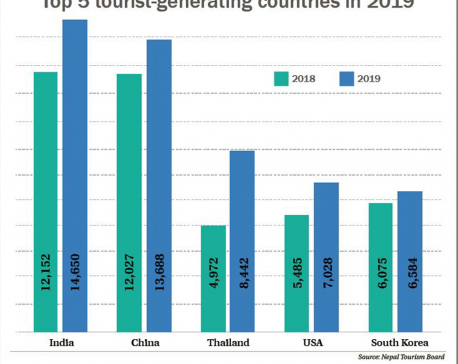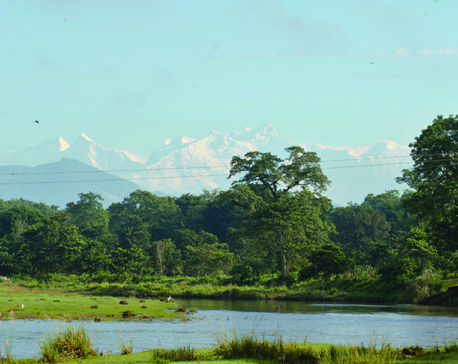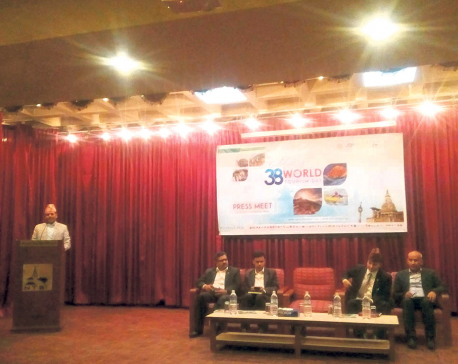
OR


Nishan Kafle
The author is a student of political science at Queens College, City University of New Yorknews@myrepublica.com
Tourism industry can help Nepal burnish its image abroad, emboldening its soft-power for a country with negligible hard-power
For a country so minuscule in size among its immediate neighbors, it is astonishing that Nepal has a number of things within its varied topography: Eight out of 10 of the highest peaks of the world, birthplace of Lord Buddha, unbelievable geographical, cultural, linguistic and religious diversity, home to exotic flora and fauna like the endangered one-horned rhinoceros and four United Nations Educational and Scientific and Cultural Organization (UNESCO) world heritage sites.
Yet, the number of tourists coming to Nepal doesn’t do justice to what Nepal has to offer.
Nepal is often listed by renowned travel websites like Lonely Planet among other prominent destinations. But disappointment arises when the word “cheap” is adjacent. It is true that Nepal is cost-effective in comparison to other destinations due to a weaker currency, but ‘cheap’ often connotes dirty, unsafe, or simply a vacation for hippies. The government should advertise Nepal not only as a budget-friendly destination, but also as a destination for the spendthrift. It should showcase Nepal as a destination worth staying at least for a week, and not just another “one day hop” in a seven day “South Asia tourism package”.
Destination 2020
Government of Nepal has launched “Visit Nepal 2020”, an ambitious project to lure two million potential visitors each year by 2020. There is a cautious optimism amongst the populace that 2020 will be remembered as the year Nepal broke the elusive glass ceiling of two million visitors especially since Nepal now has a stable government with a clear roadmap—a stark departure from the tumultuous year of 2011 when Nepal last hosted a similar ambitious project and eventually saw an astounding 22 percent increase in visitors.
Second, how can one expect the tourism industry to thrive when it is grossly underfinanced? Nepal needs to generously spend on vital infrastructures like hotels, airports and spacious roads if it aims to accommodate tourists by the millions. Equally vital is a strong national air carrier to counter the monopoly over fares from foreign competitors.
The third, and often overlooked, problem in Nepal’s travel industry is foreign investment—specifically in hotels or, worse, travel agencies altogether. A cursory glance around Thamel shows it’s littered with foreign scriptures—most of the owners being foreigners themselves. What impact will it have to the Nepali economy if most of the capital is funneled abroad? Detractors might counter saying it provides employment to job-starved Nepalis. But I believe that the capital is better invested if it is reimbursed into the Nepali economy creating more jobs and opportunities for all.
Another sidelined issue in global tourism is its impact on the environment. Now that there is a consensus among the majority of scientists that climate change is in fact a reality, it has dawned on most the necessity of assessing tourism and its correlation to environmental damage.
Nepal is specifically at a greater risk of climate change-induced disasters like flooding due to melting ice caps. For this, the government can promote “eco-tourism”: tourism that leaves very low carbon footprint due to effective use of locally available materials. Already a slew of hotels has subscribed to this idea by using alternative energy sources like solar; by recycling water, etc.
More or less Nepal’s economy is remittance based. Nepal is among the frontrunners in terms of remittance as percent of GDP (31.5 percent). This statistics is disturbing since remittance driven economies are unsustainable in the long run. It can only provide a temporary respite to the economy, but tourism can be a long-term source of income for the country.
Concomitantly, foreign employment has declined due to the unstable labor market in the Gulf and increased job opportunities at home—mostly in construction—after the 2015 mega earthquakes. Thus, capital generated from tourism can play a pivotal role in filling up the chasm left by dwindling remittances due to fewer foreign employments.
Now let us focus on what foreign nationals can do to uplift Nepal’s tourism. Similar to how Uber provided consumers with alternatives to taxis, a renaissance has happened in the hotel industry as well: Airbnb has turned the hospitality business on its head. Travelers choosing smaller homestays and Airbnb over often pricey hotels can directly contribute to the livelihoods of many whilst experiencing authentic Nepali hospitality.
Since the earthquake, there has been a deluge of donations from international development partners. Many of them even came here to volunteer or simply travel. But the international press hasn’t been all too kind. Many established news organizations fastidiously report on only the negative sides. Examples include Nepal being the most polluted country in the world.
Misreporting Nepal
They conveniently leave aside the fact that it is Kathmandu that is polluted, and not the entire country itself. Such misinformed reporting paints a misleading image of Nepal. The media also conflates certain social issues, such as chhaupadi and animal sacrifices, as a representative case of Nepali society in general. True, plenty of social evils prevail, but our progressive constitution ensures (and for which the government has undertaken decisive steps) every Nepali gets to live with dignity under the rule of law.
That said, the immutable fact remains that diversification of income is vital and no country—however small—can sustain solely through tourism. It can, however, be one of the pillars of our economy alongside export-based trade. Extreme reliance on only one sector puts the economy at serious risks.
It is discouraging to notice how countries like Egypt and Peru fish out tourists by the millions with only a handful of attractions like the pyramids and Machu Picchu respectively while Nepal, with its bountiful natural attractions, is lagging behind in numbers. Nepal should be able to harness the spillover effect of millions of Chinese and Indians traveling abroad.
Attracting only a fraction of our neighboring countries’ tourists could be a significant source of income for Nepal in the long run. Nepal may not boast the extravagance of New York, the opulence of Dubai or the nightlife of Amsterdam, but it does possess the natural beauty to capture your imagination, the adventure to boost your adrenaline, and heartwarming hospitality.
The once elusive glass ceiling of one million visitors has already been shattered. But numbers and economics shouldn’t be the only yardstick. It is tourism industry that can help Nepal burnish its image abroad, emboldening its soft-power for a country with negligible hard-power. Nepal should demonstrate to be a premium holiday destination for people from all socio-economic background, for which the government and the private sector should inculcate innovative ideas and investments.
The author is a student of political science at Queens College, City University of New York
nishankafle1997@gmail.com
You May Like This

Tourist arrivals up 25% in January
KATHMANDU, Feb 13: Nepal welcomed 91,793 foreign tourists in the first month of 2019 – a growth of 25 percent... Read More...

Visit to Chitwan National Park to be dearer
CHITWAN, Oct 25: The government has hiked the entry fee to the Chitwan National Park (CNP). ... Read More...

Tourism fraternity celebrating World Tourism Day today
KATHMANDU, Sept 25: The Nepali tourism fraternity is celebrating 38th World Tourism Day by organizing various programs across the country on... Read More...




Just In
- Nepalgunj ICP handed over to Nepal, to come into operation from May 8
- Nepal to gift two elephants to Qatar during Emir's state visit
- NUP Chair Shrestha: Resham Chaudhary, convicted in Tikapur murder case, ineligible for party membership
- Dr Ram Kantha Makaju Shrestha: A visionary leader transforming healthcare in Nepal
- Let us present practical projects, not 'wish list': PM Dahal
- President Paudel requests Emir of Qatar to initiate release of Bipin Joshi
- Emir of Qatar and President Paudel hold discussions at Sheetal Niwas
- Devi Khadka: The champion of sexual violence victims



_20240423174443.jpg)











Leave A Comment